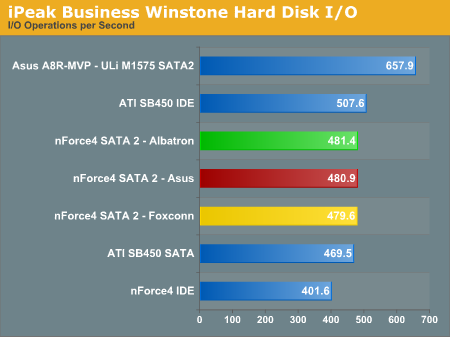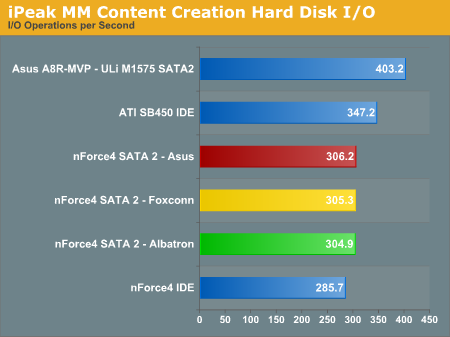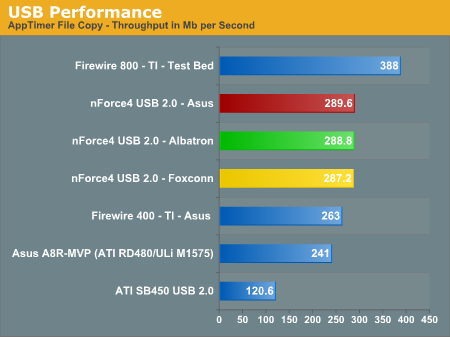nForce4 SLI Motherboards: Premium Performance at a Bargain Price
by Gary Key on January 3, 2006 12:05 AM EST- Posted in
- Motherboards
Disk Controller Performance
With the variety of disk drive benchmarks available, we needed a means of comparing the true performance of the wide selection of controllers. The logical choice was Anand's storage benchmark first described in Q2 2004 Desktop Hard Drive Comparison: WD Raptor vs. the World. To refresh your memory, the iPeak test was designed to measure "pure" hard disk performance, and in this case, we kept the hard drive as consistent as possible while varying the hard drive controller. The idea is to measure the performance of a hard drive controller with a consistent hard drive.
We played back Anand's raw files that recorded I/O operations when running a real world benchmark - the entire Winstone 2004 suite. Intel's iPEAK utility was then used to play back the trace file of all IO operations that took place during a single run of Business Winstone 2004 and MCC Winstone 2004. To try to isolate performance difference to the controllers that we were testing, we used the Seagate 120GB 7200 RPM SATA (8MB Buffer) in all tests. The drive was formatted before each test run and a composite average of 5 tests on each controller interface was tabulated in order to ensure consistency in the benchmark.
iPeak gives a mean service time in milliseconds; in other words, the average time that each drive took to fulfill each IO operation. In order to make the data more understandable, we report the scores as an average number of IO operations per second so that higher scores translate into better performance. This number is meaningless as far as hard disk performance is concerned as it is just the number of IO operations completed in a second. However, the scores are useful for comparing "pure" performance of the storage controllers in this case.
It is impressive that the ATI SB450 IDE performance tops the NVIDIA nForce4 SATA 2 performance in both benchmarks.
Firewire and USB Performance
After looking at many options for Firewire and USB testing, we finally determined that an external USB 2.0, Firewire 400, and Firewire 800 hard disk might be a sensible way to look at USB and Firewire throughput.
Our first efforts at testing with an IDE or SATA drive as the "server" yielded very inconsistent results, since Windows XP sets up cache schemes to improve performance. Finally, we decided to try a RAM disk as our "server", since memory removed almost all overhead from the serving end. We also managed to turn off disk caching on the USB and Firewire side by setting up the drives for "quick disconnect" and our results were then consistent over many test runs.
We used 1GB of fast 2-2-2-5 system memory set up as a 450MB RAM disk and 550MB of system memory. Our standard file is the SPECviewPerf install file, which is 432,533,504 bytes (412.4961MB). After copying this file to our RAM disk, we measured the time for writing from the RAM disk to our external USB 2.0, Firewire 400, or Firewire 800 drive using a Windows timing program written for AnandTech by our own Jason Clark. The copy times in seconds were then converted into Megabits per second (Mb) to provide a convenient means of comparing throughput. Higher Rates therefore mean better performance in this particular test.
With the variety of disk drive benchmarks available, we needed a means of comparing the true performance of the wide selection of controllers. The logical choice was Anand's storage benchmark first described in Q2 2004 Desktop Hard Drive Comparison: WD Raptor vs. the World. To refresh your memory, the iPeak test was designed to measure "pure" hard disk performance, and in this case, we kept the hard drive as consistent as possible while varying the hard drive controller. The idea is to measure the performance of a hard drive controller with a consistent hard drive.
We played back Anand's raw files that recorded I/O operations when running a real world benchmark - the entire Winstone 2004 suite. Intel's iPEAK utility was then used to play back the trace file of all IO operations that took place during a single run of Business Winstone 2004 and MCC Winstone 2004. To try to isolate performance difference to the controllers that we were testing, we used the Seagate 120GB 7200 RPM SATA (8MB Buffer) in all tests. The drive was formatted before each test run and a composite average of 5 tests on each controller interface was tabulated in order to ensure consistency in the benchmark.
iPeak gives a mean service time in milliseconds; in other words, the average time that each drive took to fulfill each IO operation. In order to make the data more understandable, we report the scores as an average number of IO operations per second so that higher scores translate into better performance. This number is meaningless as far as hard disk performance is concerned as it is just the number of IO operations completed in a second. However, the scores are useful for comparing "pure" performance of the storage controllers in this case.


It is impressive that the ATI SB450 IDE performance tops the NVIDIA nForce4 SATA 2 performance in both benchmarks.
Firewire and USB Performance
After looking at many options for Firewire and USB testing, we finally determined that an external USB 2.0, Firewire 400, and Firewire 800 hard disk might be a sensible way to look at USB and Firewire throughput.
Our first efforts at testing with an IDE or SATA drive as the "server" yielded very inconsistent results, since Windows XP sets up cache schemes to improve performance. Finally, we decided to try a RAM disk as our "server", since memory removed almost all overhead from the serving end. We also managed to turn off disk caching on the USB and Firewire side by setting up the drives for "quick disconnect" and our results were then consistent over many test runs.
We used 1GB of fast 2-2-2-5 system memory set up as a 450MB RAM disk and 550MB of system memory. Our standard file is the SPECviewPerf install file, which is 432,533,504 bytes (412.4961MB). After copying this file to our RAM disk, we measured the time for writing from the RAM disk to our external USB 2.0, Firewire 400, or Firewire 800 drive using a Windows timing program written for AnandTech by our own Jason Clark. The copy times in seconds were then converted into Megabits per second (Mb) to provide a convenient means of comparing throughput. Higher Rates therefore mean better performance in this particular test.











37 Comments
View All Comments
Gary Key - Tuesday, January 3, 2006 - link
Hi,I have been informed by Blue Gears that the significant differences we are seeing is due to the current beta driver set. They recently released a 64-bit driver set that improved performance up 18% in some applications. The general C-Media driver that was provided last fall was in worse shape than the June beta for the 32-bit operating systems so they went back to the drawing board. If you go back and read some of our recent Intel reviews you will see that Realtek has improved their HD codec performance by up to 40% in some instances over the last three driver releases. The A380 release we utilized for the ALC850/655 was around 9% better in Serious Sam II and BF2 (not shown yet) over the A379.
I would not be concerned with their next card at this point. They are very customer focused and are doing everything possible to improve the performance of the C-Media driver sets.
yacoub - Wednesday, January 4, 2006 - link
Thanks for the replies, Gary. Looking forward to seeing better numbers. I totally understand what you mean about scenes breaking up. I experience that as I'm waiting for the new BlueGears card to come out later this month so I'm running the onboard ALC-8xx series audio on the A8N-SLI Premium I have. It's pretty crappy and sometimes heavy action scenes with lots of sound sources seem to chug the computer and now I see that's typical of the onboard solutions.yacoub - Tuesday, January 3, 2006 - link
Considering the surprisingly poor results of the BlueGears and CLabs X-Fi cards in the actual gaming tests, why do you state that like it's an "obvious" conclusion when the numbers state exactly the inverse - that the onboard audio solutions, as cpu-grubbing as they are, actually provide the better framerates in most of the games tested?
Unless your results are anomalic, I'll have to start my soundcard research all over again. I was sold on the upcoming X-Plosion but now that it doesn't really gain me much if anything in the way of cpu usage improvement during gaming (half the purpose of getting a peripheral soundcard to begin with), I only end up with better audio quality (the other half of the purpose) and for that, yes, the BlueGears card should be better than the X-Fi series, but I really want to get better cpu usage as well. Hmmmm...
Gary Key - Tuesday, January 3, 2006 - link
The audio quality of those two sound cards are significantly better than the Realtek ALC850/655 codecs across the spectrum. Their performance at times is worse in absolute numbers but the difference in consistent frame rates while playing on-line and within the game was significant from a subjective viewpoint. We are finishing our benchmark suite for showing (consistently) the low/average/high frame rates with sound enabled. I did not publish the BF2/F.E.A.R./HL2 numbers yet as we needed time to verify the benchmarks were repeatable with the latest patch updates. However, the two add-in cards scored better and have more consistent frame rates than the on-board sound solutions. In a couple of scenes in the BF2 benchmark the on-solutions would stutter and the scence would break up, this never happened with the add in cards.
The lastest SSII patch and Creative drivers should improved the scores even further in that game. In Serious Sam II we were quite surprised by the results and they shadowed the same results from the last Intel article. Although I can make out the near/far audio effects being played with a set of high end headphones on the ALC850 codec, it in no way compares to the sounds being played back by the XFI and Mystique. The sound on the ALC850/655 is tinny and muffled while you can hear exacting details in the same scenes with the other two cards. It is even more obvious in F.E.A.R and BF2, almost to the point of wondering if you were listening to the same audio playback.
Also, the on-board ALC850/655 solutions only support up to 26 buffers in the drivers.
Thank you.
Gary Key - Tuesday, January 3, 2006 - link
Really need an edit function, hit the button before I finished proof reading.
Spacecomber - Tuesday, January 3, 2006 - link
Shouldn't the game benchmarks, at least, have focused on performance running two video cards in SLI? There was some mention in the Final Words section of using two video cards on these boards; so, I got the impression that this might have at least been tried. Still, it comes across as an after-thought, which seems to miss the point of a thorough testing of what is the main feature of these boards.Just a bit puzzled.
Space
Gary Key - Tuesday, January 3, 2006 - link
Good Day,We will have SLI benchmarks up once we complete the SLI roundup that consists of several more boards between the $80~$140 range. I might modify the article to include our initial results between the three boards tested. The issue is previous boards were tested with the 78.x drivers while these boards were tested with the 81.85 driver set. There is a significant performance difference in several benchmarks between the two driver sets that would have been confusing. We have not gone back and tested all of the boards in SLI with the 81.85 up to 81.98 drivers yet.
deathwalker - Tuesday, January 3, 2006 - link
Odd that the Albatron and Foxxcon come out very satisfactory in the testing and the don't make the Motherboard roundup that came out only 2 days ago. Great review though and it nice to see that you can save a couple $ on off-brand mobos and still get a decent product.Gary Key - Tuesday, January 3, 2006 - link
We still have several more value to mid-range SLI products to review and as such any final recommendations will be done at the completion of the testing cycle.
Calin - Tuesday, January 3, 2006 - link
On the second page, in the table, all the boards have slots for DDR2 memory. It should be DDR, I think